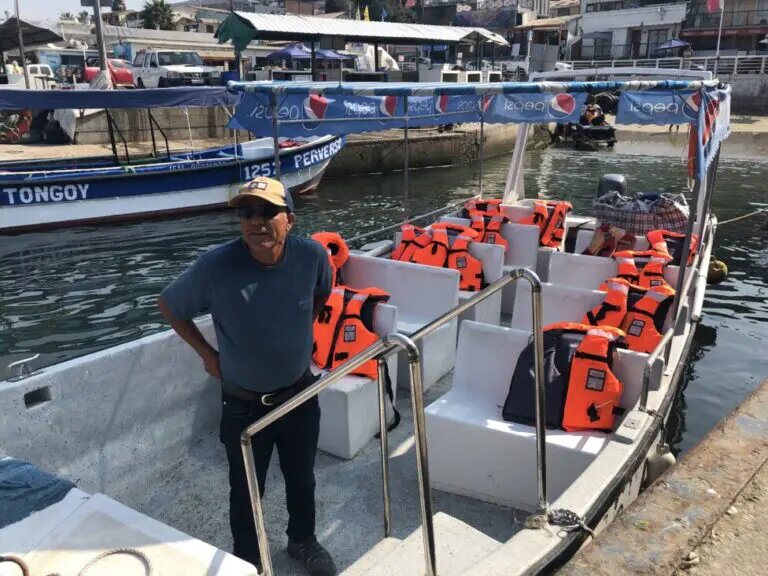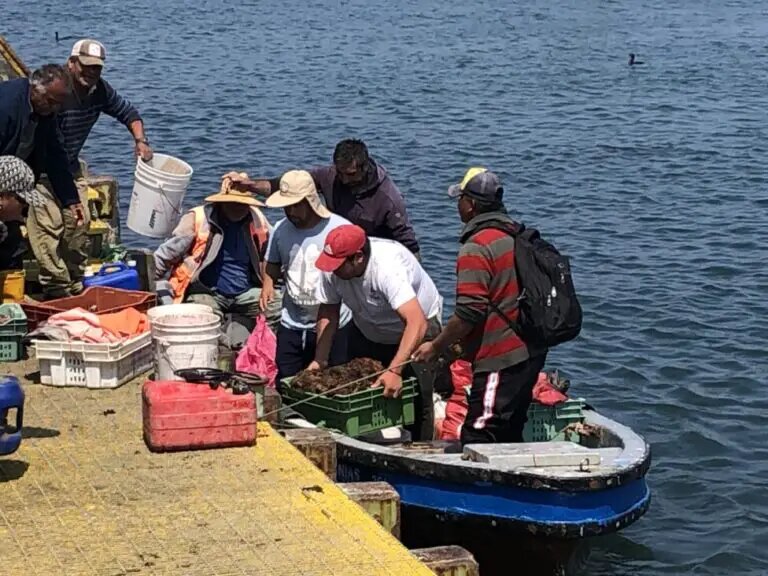
Miguel Barraza, secretary of the Chigualoco fisherpersons union in northern Chile, leans against a pile of Chilean kelp that has been drying in the sun for three days. The kelp used to fetch 1.5 dollars per kg, but the price has collapsed. CREDIT: Orlando Milesi/IPS
By Orlando Milesi
SANTIAGO, Feb 28 2023 – Management areas in Chile for benthic organisims, which live on the bottom of the sea, are successfully combating the overexploitation of this food source thanks to the efforts of organized shellfish and seaweed harvesters and divers.
Benthic organisms are commercially valuable marine species that live at the lowest level of a body of water, including sub-surface layers, such as molluscs and algae.
The most widely harvested molluscs in Chile include the Chilean abalone (Concholepas concholepas), razor clam (Mesodesma donacium) and Chilean mussel (Mytilus chilensis), and the most harvested algae is Chilean kelp (Lessonia berteorana).“When there is free unregulated access, the resources do not recover, they tend to be overexploited and in the end there is nothing left. The only places where you can see these resources is in the management areas because fisherpersons are obliged to take care of them and help them recover.” — Luis Durán Zambra
.
The Undersecretariat for Fisheries and Aquaculture told IPS that in this country with a long coastline on the Pacific Ocean there are currently 853 Benthic Resources Management and Exploitation Areas (AMERB), with a total combined surface area of close to 130,000 hectares.
The areas vary in size from one to 4,000 hectares, although 91 percent are under 300 hectares and the average is 150 hectares. They range from beaches and rocky coastal areas to places that are a maximum of five nautical miles offshore.
They were created in 1991, when geographical sectors were established within reserve areas for artisanal fishing in order to implement management plans, which set closed seasons, regulated catches and outlined recovery measures, and which are only assigned to organizations of legally registered artisanal fisherpersons.
The aim is to regulate artisanal fishing activity, restricting access to benthic organisms, under the supervision of the authorities.
Leaders of three local fishing coves or inlets that operate as production units where artisanal fisherpersons extract and sell marine resources told IPS about the efforts made to prevent poaching, and underscored the benefits of sustainable exploitation of these resources.
They said they managed to make a living from their work but expressed fears about the future.
This South American country of 19.2 million people has 6,350 km of coastline along the Pacific ocean and is among the world’s top 10 producers of fish.

Luis Durán Zambra presides over the Association of Guanaqueros Fisherpersons in Chile, which brings together 170 members, 70 of whom are registered for the assigned management area. Durán poses in his boat where he drives up to 20 tourists around the bay, an activity with which he earns extra income during the southern hemisphere summer. CREDIT: Orlando Milesi/IPS
It has 99,557 registered artisanal fisherpersons, of whom 25,181 are women. There are 13,123 registered artisanal fishing vessels and 403 industrial fishing vessel owners. The country also has 456 fishing plants that employ 38,014 people, according to data provided by the Undersecretariat of Fisheries in response to questions from IPS.
As of October 2022, there were 1,538 aquaculture centers and 3,295 aquaculture concessions, 69 percent of which involved companies that employ a total of 10,719 people.
The Undersecretariat said it is in the process of creating 516 new AMERBs, and that in more than 30 years under the system 435 proposals have been rejected and the status of 34 sectors has been canceled.
Leaders of fisherpersons unions describe different realities
Luis Durán Zambra, president of the Fisherpersons Association of Guanaqueros, a town in the Coquimbo region, 430 kilometers north of Santiago, said that these areas have been very successful.
“When there is free unregulated access, the resources do not recover, they tend to be overexploited and in the end there is nothing left. The only places where you can see these resources is in the management areas because fisherpersons are obliged to take care of them and help them recover,” he told IPS during an interview in his cove.
Durán, 64, is the fifth generation of fishermen in his family.
The unions, advised by marine biologists, analyze each management area, its conditions, the reproduction of resources and then inform the Undersecretariat of Fisheries to authorize the size of the annual harvest.

Tasting seafood and fish ceviches – a local dish – in the market of the Tongoy resort town, in the Coquimbo region in northern Chile, is also an opportunity to educate tourists on the flavor and nutritional value of these products fresh from the sea. CREDIT: Orlando Milesi/IPS
Miguel Tellez, president of the Mar Adentro de Chepu Artisanal Fisherpersons Union, on the island of Chiloé, 1,100 kilometers south of Santiago, told IPS that they have worked for 20 years in four 300-hectare management areas that start at the Chepu River, where they harvest different molluscs.
The main species they harvest is the Chilean abalone, although there are also mussels, sea urchins (Echinoidea) and red seaweed (Sarcothalia crispata) that is harvested in the southern hemisphere summer. The production of Chilean abalone varies, but in a good year 400,000 are caught.
“We are 34 active members, half of us divers, who monitor the entire year, with four people taking turns overseeing day and night for six days,” Tellez said from his home in the town of Chepu.
He explained that poaching “has been our main problem, especially when we just started.”
He was referring to illegal fishermen and divers who enter the management zones, affecting the efforts of those legally assigned to exploit and protect them.
His union installed surveillance booths on the coast of Parque Ahuenco, a reserve belonging to some fifty families that preserve 1,200 hectares along the sea.
Tellez is worried about the future because the average age of union members is 40 years old.
“I don’t know how much longer we can do this. There are very few young people and because of their studies they are involved in other things,” he said.
In Chepu, fisherpersons sell Chilean abalone in the shell to a factory in the nearby town of Calbuco where they are cleaned and packaged for sale within Chile or for export. The price depends on the market. It has now dropped to 60 cents of a dollar per abalone.
“This is a low price given that we have to oversee the shellfish year-round, paying dearly for fuel, motors and boats and making a tremendous investment. An outboard motor, like the ones we use, costs 40 million pesos (about 50,000 dollars),” said Tellez.

At the pier in Tongoy, a seaside resort in northern Chile, shellfish divers prepare piures (a kind of sea squirt), which they try to sell to tourists by explaining how to eat them. CREDIT: Orlando Milesi/IPS
He is dubious about moving towards industrialization, asking “How much more could we harvest and how much more would we have to invest?”
Proudly, he said his was “one of the best unions in the country. Partly because we are from the same area,” since all of the members live in Chepu or nearby towns.
In the Coquimbo region, Miguel Barraza, secretary of the Chigualoco fisherpersons union, 248 kilometers north of Santiago, is enthusiastic about transforming his cove.
At the cove, he told IPS that “1.1 billion pesos (1.37 million dollars) are going to be invested to make this a model cove. A new breakwater will be built, along with a bypass on the freeway and facilities to serve tourists.”
The new breakwater will protect boats from waves as they enter and exit the cove.
Thirty members and their families, including shellfish divers, fisherpersons and kelp harvesters, live in Chigualoco.
They have three management areas, the largest of which is 5000 square meters in size. From these areas they harvest 100,000 Chilean abalones and 300 tons of Chilean kelp a year.
“We earn enough to live year-round,” Barraza said, adding that they were not interested in processing their catch because “fishermen like to come ashore and sell.”
“We have overseers, but poachers come in from various sides. They are stealing a lot. We won a project to buy a drone to monitor the shore to find them,” he said.
In Guanaqueros, where Durán’s union is located, despite their seniority they have only now registered a management zone in their overexploited fishing area.
“We have an area that is not yet well developed. It has been difficult for us because most of us are fisherpersons. But the area is going to recover. The marine biologist says that 100,000 abalones could be harvested annually,” said Durán, looking for a shady spot to chat in his cove.
Today the area is looked after. It is about three kilometers in size and before it began to be regulated, people harvested abalone there for more than half a century without any limits.
“People are used to just harvesting without regulations and it is difficult to change that behavior. It’s a constant struggle and a problem to prevent disputes between fisherpersons…Many do not understand that the resources are there because other people take care of them,” he said.

As soon as fisherpersons and divers unload their products at the Tongoy pier, in the northern Chilean region of Coquimbo, crowded with tourists during the southern hemisphere summer, they are approached by customers seeking to buy products directly, without the need for intermediaries. CREDIT: Orlando Milesi/IPS
Low consumption of seafood, a public health problem
Durán lamented the low levels of consumption of fish and shellfish in Chile, despite the country’s abundant seafood.
“We don’t have culinary habits like in Peru (a country on Chile’s northern border) and we eat what we shouldn’t. There is no government promotion or policy that calls for consumption and it is a public health issue,” he said.
“I can’t conceive of the fact that there is a plant making fishmeal from Chilean jack mackerel (Trachurus murphyi) and that children are eating tilapia (Oreochromis niloticus),” a farmed fish, he added.
The Undersecretariat informed IPS that the annual consumption of seafood in 2021 was 16.6 kg per inhabitant, below the global average of 20 kg.
In Chile, fishing is the third largest economic activity, contributing around five billion dollars a year to the economy.
Chile is among the 10 largest fish producing countries in the world and is the global leader in aquaculture, second in salmon production and first in mussel exports.
The Undersecretariat is currently drafting a new law on the exploitation and conservation of seafood, for which it organized 150 meetings with artisanal fishermen and another 22 with representatives of industrial fishing and sector professionals.
The Undersecretariat told IPS that the objective is to promote and diversify the activity not only as a development strategy but also as a resource conservation strategy.